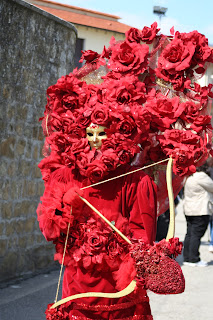Firenze, July 26
On the 26th of July the ouster of Duke of Athens Walter of Brienne marks in Florence; the Duke came to power thanks to the internal dissensions in the Florentine ruling class.
The Florentine people rebelled against the oppression and violence,and on the 26th July 1343 he succeeded in expelling the Duke from town.
From that day on St. Anne was proclaimed Patron Saint of the freedom of the city and 26 July became so feast day.
The new Signoria decided to put the effigy of the saint in Orsanmichele, which was the church and granary of the city. Putting the image of the saint indicated the official and civic nature of the "new religion", the veneration that you wanted to pay tribute.
The altar became the focus of the festival, around it were crowding the faithful offering gifts to the figure of St. Anne.
Then it was decided that every 26 July the image of St. Anne in Orsanmichele were decorated with the flags of the arts and the people went to bring as a gift candles or coins.
The tradition has remained to the present day, including the start of the parade at 9.00 p.m from Palazzo Vecchio, which will join the commissioner to the folk traditions with the Banner of Florence, in order to reach the churchyard of Santa Maria del Fiore by via dei Calzaiuoli. At this point the religious authorities will join the procession, by via Roma and they reach the church of Orsanmichele to offer the traditional blessing of the candles.

Firenze, 26 luglio
Il 26 luglio ricorre per Firenze la cacciata del Duca d’Atene Gualtieri di Brienne, salito al potere grazie alle discordie interne alla classe dirigente fiorentina.
Il popolo fiorentino si ribellò ai soprusi ed alle violenze e, proprio il 26 luglio 1343 riuscì a cacciare il Duca dalla città.
Da quel giorno Sant’Anna fu proclamata Santa protettrice della libertà della città e il 26 luglio divenne così giorno di festa.
La nuova Signoria decise di porre l'effige della santa in Orsanmichele, che era chiesa e granaio della città. Mettere l'immagine della santa stava, quindi, ad indicare l'ufficialità e la natura civica del "nuovo culto", della venerazione che le si voleva tributare.
L'altare divenne il fulcro della festa, intorno ad esso si affollavano i fedeli offrendo doni alla figura di Sant'Anna.
Si decise così che proprio a Orsanmichele ogni 26 luglio l’immagine di Sant'Anna venisse addobbata con le bandiere delle arti e che il popolo si recasse a portare in dono ceri o monete.
La tradizione è rimasta fino ai nostri giorni e prevede la partenza del corteo storico alle 20.45 da Palazzo Vecchio, cui si unirà l'assessore alle tradizioni popolari con il Gonfalone di Firenze, per giungere sul sagrato di Santa Maria del Fiore per via Calzaiuoli. A questo punto le autorità religiose si uniranno al corteo che, per via Roma, raggiungerà la chiesa di Orsanmichele per al tradizionale offerta e benedizione dei ceri. Segui Tuscany in a nutshell su Google+






